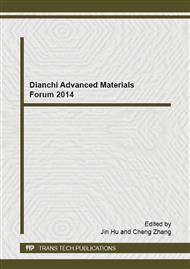p.261
p.265
p.270
p.274
p.279
p.285
p.290
p.297
p.302
Evaluation of PAN Based Composite Sheet Films with Modified Carbon Nanotubes
Abstract:
An aqueous deposited polymerization method to fabricate PAN based composite sheet films after multiwall carbon nanotubes (CNTs) modified with concentrated nitric acid was presented. This paper disscussed the effect of CNTs modified with concentrated nitric acid on the thermal and the crystal properties of PAN based composite sheet films. The results indicated that the normal process of multiwall CNTs treated with concentrated nitric acid can change the crystallization properties of polymers but not change the basic structure of polymers. The crystallinity of pure PAN at 2θ≈17° was strengthened after preoxidation. With the addition of CNTs, the crystallization peak of composite sheet films at 2θ≈17° became weaker, and a sharp crystallization peak appeared at 2θ≈25°, as showed that the composite sheet films could carry out the cyclization at low preoxidation temperature. During their process of preoxidation and carbonization, modified CNTs could promote the formation of cyclization and cause the formation of aromatic ring structure, and the cyclization efficiency increased from 20.24% to 70.41%. TEM analysis indicated that the modified CNTs existed in the composite sheet films in two forms: the dispersion and reunite of the single state. The test results of the surface resistivity of the composite sheet films showed that when the CNT content was lower, the surface resistivity of film was very large. When the CNT content was 5% and 10%, the surface resistivity of the film was 5.74 MΩ and 0.15 MΩ, respectively. It was obvious that once the continuous conductive network of CNTs was formed, the surface resistivity of composite sheet films hardly changed.
Info:
Periodical:
Pages:
279-284
Citation:
Online since:
November 2014
Authors:
Price:
Сopyright:
© 2014 Trans Tech Publications Ltd. All Rights Reserved
Share:
Citation:


